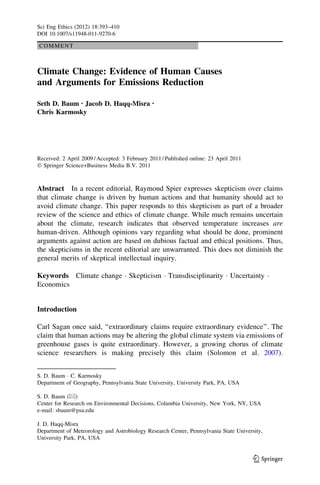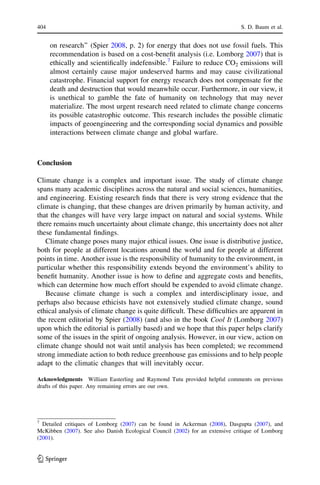1) The document summarizes evidence that human-caused greenhouse gas emissions are driving observed increases in global temperatures. It discusses the complex, interdisciplinary nature of climate change research and refutes claims that the field is motivated by funding or politics.
2) Key aspects of Earth's climate system are described, including the greenhouse effect which makes the planet habitable. The role of human emissions of greenhouse gases in increasing surface temperatures is explained, though uncertainties remain about future impacts.
3) The skepticism expressed in a recent editorial by Spier is addressed. While skepticism can be valuable, the evidence indicates Spier's specific doubts regarding temperature data and ice core records are unwarranted.









![literature include those based on rights (Adger 2004; Caney 2008) and virtue
(Jamieson 1992). Some major issues include how much emissions reductions to aim
for (Baum 2007; Tol 2008), how to distribute permissions to emit (Neumayer 2000),
how to handle uncertainty about the climate-society system (Brown 2003), and how
to help humans and ecosystems adapt to what climatic changes will inevitably occur
(Adger et al. 2006; UNDP 2007). Collectively, this research makes a clear and
compelling case that climate change poses many major ethical issues. Initial
research has shed some light on these issues, but much work remains undone.
Climate Economics
Economists often frame climate change as a market failure, meaning that markets
fail to account for the costs and benefits of climate change in the prices of the
greenhouse gas emissions that are responsible. The Stern Review calls climate
change ‘‘the greatest and widest-ranging market failure ever seen’’ (Stern 2007, p.
i).5
In response to this ‘‘market failure’’, economists typically recommend some sort
of ‘‘market-based’’ climate policy, usually in the form of a global carbon tax or cap-
and-trade system, with the tax usually being the preferred option. [See Nordhaus
(2007) for a common argument in favor of a carbon tax.] Climate economics
research thus focuses on the rate of taxation by building in more detail about the
climate system (e.g. McInerney and Keller 2007), about society (Howarth 2006), or
by considering alternative ethical frameworks (see Baum 2007).
Climate economics research is dominated by a line of integrated climate-society
modeling based on a particular ‘‘optimal growth’’ model known as the Ramsey
model. This line of modeling has its origins in the work of Nordhaus (1992); Tol
(2008) provides a recent review of the literature. There has been extensive ethical
debate on how to choose parameter values for the model (Arrow et al. 1996; Baum
2007). In addition, the model has also been heavily criticized for its accuracy (c.f.
Baum 2007; Gundermann 2002; Stern 2008) as well as for its sweeping assumption
that there exists a universal decision maker for the entire planet (c.f. Morgan et al.
1999; Schelling 2000).
Some recent economic analyses of climate change have focused on the
possibility that climate change could be catastrophic, meaning that it could have
very large negative outcomes (Tol and Yohe 2007; Weitzman 2009). The analyses
find that the possibility of catastrophe may be a very important factor even if the
catastrophe is quite unlikely. This finding parallels general analyses of catastrophic
risk (e.g. Bostrom 2003; Bostrom and C´ irkovic´ 2008; Matheny 2007; Posner 2004).
The basic idea is that under ethical frameworks that place intrinsic value on human
life and welfare, risks of ending human civilization or even causing human
extinction should be avoided, perhaps even at all costs.6
Thus, the possibility that
5
The Stern Review is a report on climate change commissioned by the UK government and lead by
economist Nicolas Stern. The Review was heavily criticized by many economists, in large part for
supporting a different ethical view than that of the critics (Baum 2007).
6
Tonn (2002) demonstrates that ecocentric frameworks will often also place high priority in avoiding
human extinction given the crucial role humanity may play in the very long-term survival of Earth-
originating life.
402 S. D. Baum et al.
123](https://image.slidesharecdn.com/climate-140623094644-phpapp02/85/Climate-10-320.jpg)
![climate change could be catastrophic suggests, under these frameworks, that much
effort should be made to reduce greenhouse gas emissions.
There are several scenarios in which climate change could be catastrophic,
causing major and possibly irreversible harm to human civilization. One scenario
involves a combination of high climate sensitivity and high emissions levels,
leading to large amounts of climate change (Weitzman 2009). There is a chance that
this scenario can be avoided via geoengineering. However, geoengineering does not
offset all climate impacts and could itself lead to a catastrophic scenario in the event
that it was abruptly ceased or used as a weapon (Robock 2008). Another
catastrophic scenario, possible under even more moderate climate change, involves
climate change contributing to a major global war. Already, some analysts expect
climate change to exacerbate violent conflict due to such stressors as resource
scarcity and migration (Sullivan et al. 2007); it is difficult to place an upper bound
on how catastrophic such conflict could get. Thus, for those ethical frameworks that
value future lives or welfare (human or otherwise), avoiding climate change should
be a major priority.
Spier’s Claims
In his editorial, Spier (2008) makes specific claims that are worth considering in
greater detail.
1. An ‘‘increase in global temperature has beneficial effects as well as detrimental
ones’’ (Spier 2008, p. 2). This claim is certainly true, and importantly so. While
climate change is primarily caused by the world’s rich, the detrimental effects
fall predominantly on the world’s poor, causing a major case of distributive
injustice, or, in legal terms, a tort (Sunstein and Rowell 2007). Furthermore,
unlike the rich, the poor typically are less able to adapt to climate change,
leading to a situation that Desmond Tutu calls ‘‘adaptation apartheid’’ (UNDP
2007, p. 166). Meanwhile, groups that stand to benefit, such as the energy
companies whose products drive climate change, may (and often do) hinder
efforts to reach a strong global climate policy (Demeritt 2001; McKie and
Galloway 2007).
2. ‘‘[S]pending money on attempts to limit or lessen the amount of CO2 in the
atmosphere are not cost effective in achieving human benefits when the money
could be spent otherwise’’ (Spier 2008, p. 2). The accuracy of this claim
depends on the extent to which benefits to future humans are included. Ethicists
frequently argue that all humans should be valued equally, regardless of when
they live (c.f. Broome 1992). Under this view, efforts to prevent catastrophes,
including catastrophic climate change, are generally the most cost-effective;
ongoing research aims to estimate the most cost-effective means of reducing
catastrophic risk (Bostrom and C´ irkovic´ 2008). This claim of Spier’s is based
on an analysis (Lomborg 2007) which does not consider catastrophic risk and is
thus ill-founded.
3. ‘‘[T]he global community should let the CO2 rise as it may and spend the
money that the populace seems to want to devote to its stabilization or reduction
Evidence of Human Causes and Arguments 403
123](https://image.slidesharecdn.com/climate-140623094644-phpapp02/85/Climate-11-320.jpg)







